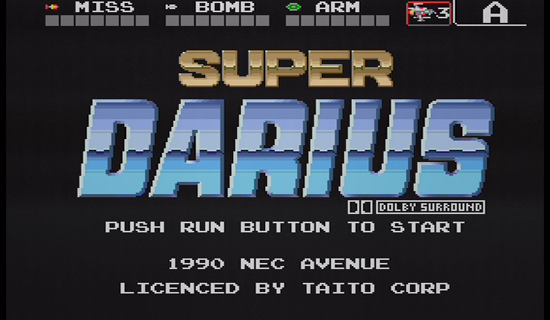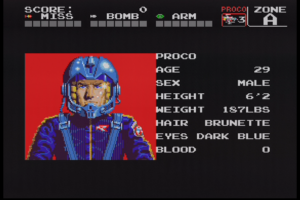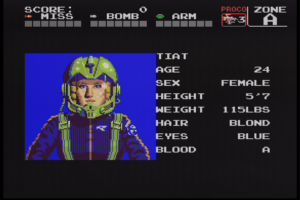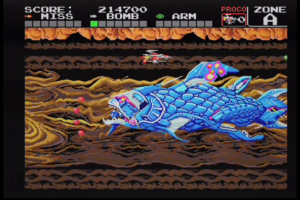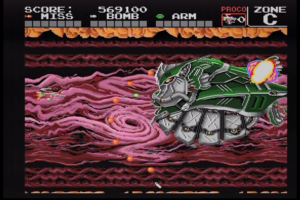It took four years from the release of the arcade version of Darius before this first port appeared on the PC Engine CD. It took only just about a year for Gradius to make it from the arcade to the Famicom, but there isn’t much debating that Darius was much more of a challenge technically to port. Its unique three monitor setup and emphasis on the soundtrack almost guaranteed that a port wouldn’t be able to hold up.
Naturally that sort of long display setup couldn’t be replicated on any home hardware at the time, so the solution was to zoom in the graphics quite a bit, making the sprites bigger but the field of play smaller. The larger sprites definitely look nice, and from a visual perspective the graphics hold up well against the original. The problem is that the game was designed with a wider field of play in mind, so zooming that in and reducing it really has a big impact on how the game plays.
Darius isn’t afraid to throw a lot of enemies at you at once, and the increased screen space helped make that more manageable. Here you get less time and space to react in, and just as many enemies to deal with. And though the enemy patterns aren’t actually any different than the original, I would imagine the zoomed-in view makes for a lot of re-learning for those who had spent a lot of time with Darius in the arcade. I’m no expert at the original, but I can consistently get much further in it than in Super Darius. Another negative side effect is that the whole screen is never completely visible vertically, so there’s a tiny bit of scrolling whenever you more far enough up or down. This port also doesn’t allow for any continues at all.
The negative points don’t quite end there though. Super Darius also has a reasonably major bug if you’re playing for score: If you turn your Missile weapon into the wave beam, you never actually get any points when you kill enemies with it. The 2 player simultaneous play that the arcade version featured is also missing from this port, due to technical limitations of how many sprites could appear on the screen at once (more on that below). At one point its inclusion was planned, since images of the game appeared in Japanese game magazines with two players on screen.
Super Darius does have plenty of good points as well. The background parallax scrolling from the original was retained using some sprite trickery, and this was the reason that the 2 player simultaneous play was cut. They had to choose one or the other, and apparently parallax scrolling won. Though the game doesn’t allow for any continues, it is kind enough to revive you right at the spot where you died. This is a kindness that the arcade version absolutely did not have! And since this game was on a CD, the original Darius soundtrack is well in tact here. In fact the audio was recorded from the original arcade board. Super Darius is also the very first home video game to feature Dolby Surround Sound. It’s very clear that Bits Laboratory understood the importance of sound to Darius.
There’s still one other unique advantage that Super Darius has that may make a fan pick it up over any other port though. The plan for the original Darius was to feature 26 different bosses, one for each possible zone in the game’s branching paths. That never came to be, but apparently the designs for those bosses were still around, because they’re fully implemented in this port! So while you still get all of your old favorites like King Fossil, Electric Fan, Dual Shears, and Fatty Glutton, you now get Burst Out, MyHome Daddy, Guard Savage, Buddy Blazer, and more!
A boss rush mode can also be accessed from the title screen by holding Down+Select on controller 1, Up+Run+I on controller 2, and then pushing Run on controller 1. It allows you to go through all 26 of the game’s bosses back to back, automatically assigning you power-ups along the way.
There was also a campaign when the game was released for a chance to win Sony 3D glasses in a Super Darius branded package. This listing for them on Japanese game shop Surugaya’s site suggests that they produced a cheap “3D effect” by having one lens be dark and the other not, sort of delaying the incoming image. Since Darius is a horizontal scrolling shooter, I could see this giving some kind of small feeling of depth to the game.
For a real die hard fan of the original Darius, the extras found here you might be enough to make up for the zoom-in that will no doubt throw off play. It’s not like that’s an insurmountable obstacle, it just means you have to re-adapt to a game that you’ve presumably already adapted to. I just wasn’t willing to put in the time to re-learn the game, even if the reward was getting to see some of the previously cut bosses. Also it’s just a good port in general, considering the unique qualities of the game being ported and technological limitations of console hardware at the time.
This specific version of Darius was also made available on the Wii Virtual Console, and there’s even an argument for the Virtual Console version being superior. Since the game was emulated using frame buffering for the sprites, the relatively minor sprite flicker found when playing the game on original hardware is just not there in the Virtual Console version.
